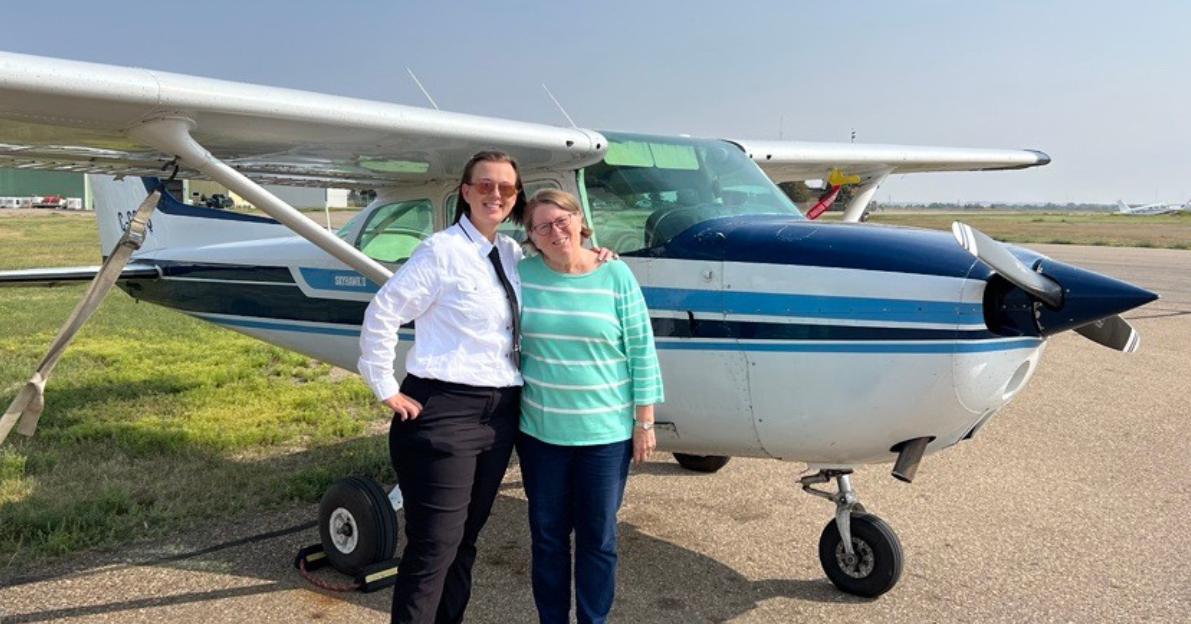
PRPS Teacher Successfully Lands Commercial Pilot's License
Photo: Dana Marshall stands next to Terry Super from Super T Aviation after completing her commercial pilot's test
It’s no small feat getting a commercial pilot’s license, particularly if it's on the side to a number of other roles, such as teaching chemistry, physics and math at Eagle Butte, being co-lead of the DR South Alberta Flight Academy, the local ATA president, a mother, rancher, and a volunteer wildland firefighter with the Cypress County Elkwater Fire Station. However, almost three years from when Dana Marshall did her discovery flight, she has done just that.
Marshall has no plans to become a professional pilot as she wants to remain a teacher, but after encouragement from Super T and Superintendent Dr. Reagan Weeks, she decided to train towards a commercial pilot’s license, which is a prerequisite for getting an instructor’s license. Marshall and Katelyn Rozdeba, the other co-lead of the flight academy, are the certified teachers of the program but are unable to teach ground school or flight training without an instructor’s license. They are responsible for all aspects of the academy aside from flight training, such as ensuring the students fulfill curriculum credits, organizing field trips, first-aid, and other non-flight training events.
The flight exam for a commercial license is very similar to that for a private license except the pilot must be more precise in their flying. The ground school portion or written exam is vastly different. “There is a ton more knowledge to learn for the commercial written exam,” explained Marshall. “They say it is one of the toughest exams you can write in Transport Canada.”
The pilot needs a minimum of 200 hours flying time with at least 100 of those hours as piloting command time, which is flying solo. Additionally, they need a certain amount of instrument flying time where the pilot wears a helmet to block their vision, so they are flying by instruments alone, with an instructor beside them, to simulate flying in a cloud.
“I like to fly with my kids if they are up for it, I have an 11 and a 5-year-old. Now they are bored with it, so a lot of the time, I message the students to see if they want to go flying, if they want to hang out and go for a trip,” said Marshall. “All those solo hours get lonely after a while so it’s better to fly with someone. I’ve taken a few staff members and a few students up.”
Marshall sat the written exam on April 4, 2023, and passed the flight exam on September 1, 2023. Since then, she’s been flying off the needed hours and checking off the rest of the required boxes. “With the private you can do either/or first,” explained Marshall. “With the commercial, they want the written passed first and then you do the flight test. You can do the flight test as early as 150 hours and then you just get all the other flight hours in.”
Marshall kept a logbook of her flight hours, and a pilot training record also shows which instructor was supervising and what Marshall was working on. Transport Canada requires this because when the submission is made for the commercial license, Super T must prove she completed all the requirements.
“I flew all around Alberta, Saskatchewan and went to BC a couple of times. Part of the commercial is a 300 nautical mile flight from your starting point to the destination and there are approved routes you can do. I went to Yorkton, Saskatchewan and you have to stop twice, at two places that aren’t your destination. You have to stop for gas anyway, so I stopped in Regina, Yorkton and then at Regina on the way back. It’s all about gaining more experience, getting to more airports, being able to be in different types of airspace, that is what they are trying to teach you by having these certain rules,” stated Marshall.
Medicine Hat and Lethbridge have a flight services station because they aren’t busy enough to have a tower. Marshall had never been in Class D airspace before or talked to a tower, but she had to when she landed and departed from Regina.
“Class C airspace, which is very busy, would-be Calgary International, Springbank and Edmonton International. There are multiple different frequencies you talk to, there might be an outer frequency, an inner frequency when you are coming in then you must dial in a new radio station once you land to talk to ground control, it’s a whole bunch of different pieces of training. For the night rating, we get to land at Calgary International. I had an instructor with me and that was my first ever experience with Class C and it was overwhelming because they spit stuff out of you and their instruction is at 100 miles an hour and you are not only flying the plane, but you are also trying to take down their instructions. Landing is a higher stress situation, a critical moment of flight, and you have to write down where they want you to exit, taxi to and your frequencies and instructions. You need a plan ahead of time in order to be able to catch it all.”
For the moment, Marshall is reveling in completing her commercial license training. Currently, Super T has a new grant where they can train up to 15 instructors. “I might try to take advantage of that, but I also don’t want to take that opportunity away from a young pilot that wants the instructor rating to go onto an airline job. I have no plans to become an airline pilot, so for me to take up a spot someone else could use, I would feel rotten about that. I’m sitting back and enjoying and letting my brain chill out for a while and not being in constant training like I have for the past three years,” concluded Marshall.
By Samantha Johnson, Prairie Rose Public Schools Content Writer







